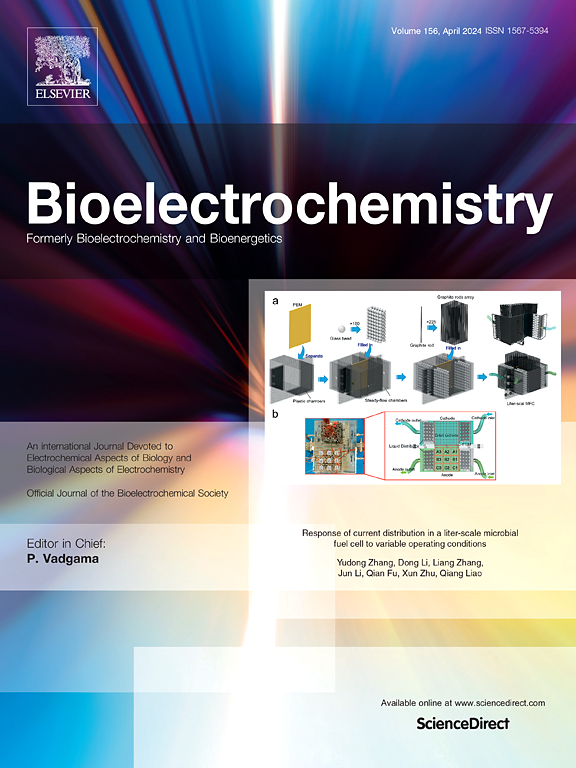A novel label-free immunosensor for detection of VEGF using FFT admittance voltammetry
IF 4.8
2区 化学
Q1 BIOCHEMISTRY & MOLECULAR BIOLOGY
引用次数: 0
Abstract
This study presents a novel, label-free electrochemical immunosensor for the detection of vascular endothelial growth factor (VEGF), a crucial tumor biomarker. The immunosensor was developed by electrochemical deposition of gold nanoparticles-reduced graphene oxide (AuNPs-rGO) nanocomposite on glassy carbon (GC) and screen-printed carbon (SPC) electrodes. A specific monoclonal antibody against VEGF was immobilized on the electrode surface through a carbodiimide coupling reaction. Field Emission Scanning Electron Microscopy (FE-SEM), X-ray Diffraction (XRD), cyclic voltammetry (CV), and electrochemical impedance spectroscopy (EIS) have been used to characterize the developed immunosensor. For quantitative measurement of VEGF, fast Fourier transformation admittance voltammetry was employed by applying a special potential waveform on the immunosensor and sampling the currents. The response was determined by measuring changes in the electrode admittance caused by the adsorption of VEGF molecules, without the use of a redox probe. Under optimal conditions, the immunosensor responses were within a linear detection range for VEGF from 0.1 to 10,000 pg/ml and from 10 to 10,000 pg/ml, with notably low detection limits of 29.1 fg/ml and 352 fg/ml for the modified GC and SPC electrodes, respectively. The sensor exhibits minimal interference from common serum proteins, making it a promising candidate for sensitive, low-cost commercialization.

利用FFT导纳伏安法检测VEGF的新型无标记免疫传感器
本研究提出了一种新的、无标记的电化学免疫传感器,用于检测血管内皮生长因子(VEGF),这是一种重要的肿瘤生物标志物。将金纳米颗粒-还原氧化石墨烯(AuNPs-rGO)纳米复合材料电化学沉积在玻碳(GC)和丝网印刷碳(SPC)电极上,开发了免疫传感器。通过碳二亚胺偶联反应将特异的VEGF单克隆抗体固定在电极表面。利用场发射扫描电镜(FE-SEM)、x射线衍射(XRD)、循环伏安法(CV)和电化学阻抗谱(EIS)对所研制的免疫传感器进行了表征。为了定量测量VEGF,采用快速傅立叶变换导纳伏安法,在免疫传感器上施加特殊的电位波形并采样电流。在不使用氧化还原探针的情况下,通过测量由VEGF分子吸附引起的电极导纳变化来确定响应。在最佳条件下,免疫传感器对VEGF的检测在0.1 ~ 10,000 pg/ml和10 ~ 10,000 pg/ml的线性范围内,修饰GC和SPC电极的检测限分别为29.1 fg/ml和352 fg/ml,检测限较低。该传感器显示最小的干扰,从普通血清蛋白,使其成为一个有希望的候选敏感,低成本的商业化。
本文章由计算机程序翻译,如有差异,请以英文原文为准。
求助全文
约1分钟内获得全文
求助全文
来源期刊

Bioelectrochemistry
生物-电化学
CiteScore
9.10
自引率
6.00%
发文量
238
审稿时长
38 days
期刊介绍:
An International Journal Devoted to Electrochemical Aspects of Biology and Biological Aspects of Electrochemistry
Bioelectrochemistry is an international journal devoted to electrochemical principles in biology and biological aspects of electrochemistry. It publishes experimental and theoretical papers dealing with the electrochemical aspects of:
• Electrified interfaces (electric double layers, adsorption, electron transfer, protein electrochemistry, basic principles of biosensors, biosensor interfaces and bio-nanosensor design and construction.
• Electric and magnetic field effects (field-dependent processes, field interactions with molecules, intramolecular field effects, sensory systems for electric and magnetic fields, molecular and cellular mechanisms)
• Bioenergetics and signal transduction (energy conversion, photosynthetic and visual membranes)
• Biomembranes and model membranes (thermodynamics and mechanics, membrane transport, electroporation, fusion and insertion)
• Electrochemical applications in medicine and biotechnology (drug delivery and gene transfer to cells and tissues, iontophoresis, skin electroporation, injury and repair).
• Organization and use of arrays in-vitro and in-vivo, including as part of feedback control.
• Electrochemical interrogation of biofilms as generated by microorganisms and tissue reaction associated with medical implants.
 求助内容:
求助内容: 应助结果提醒方式:
应助结果提醒方式:


